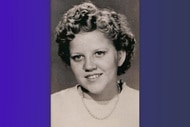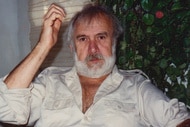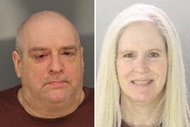Create a free profile to get unlimited access to exclusive videos, breaking news, sweepstakes, and more!
'Unsolved Mysteries' Actually Helped Crack More Than 200 Cases. Here Are 6 Notable Ones
One of the cases "Unsolved Mysteries" helped crack has a surprising link to Oscar-winner Matthew McConaughey.

In its original run during the 1980s, '90s and early 2000s, "Unsolved Mysteries" captivated audiences with more than 1,000 seemingly unsolvable cases, but what audiences may not know is that the show actually helped crack a good number of those mysteries.
"Unsolved Mysteries," which was revived on Netflix this week, has gone through multiple incarnations — with the most famous run being the original run with host Robert Stack.
Though the show famously mixed factual cold cases with mythological folklore involving Bigfoot and unidentified flying objects, it covered a number of real-life disappearances and unsolved crimes and achieved success in its call to viewers for information that might prove crucial to unraveling mysteries.
"We’ve solved over 260 cases," show creator Terry Dunn Meurer told Oxygen.com of the more than 1,300 cases they covered.
"That’s one of the exciting things about having been involved with this series for as many years as i have; it just keeps going and cases just keep getting solved. It’s very gratifying and it's a very gratifying show to work on," Meurer said.
Here are some of the cases that saw closure after "Unsolved Mysteries" put a spotlight on them.
1. Missy Munday and Jerry Strickland
The 1988 case of fugitive couple Missy Munday and Jerry Strickland was where "Unsolved Mysteries" appeared to have the most immediate impact.
Munday, then 17, and Strickland, then 26, were wanted in Michigan for the murder of Elmer DeBoer in 1987, and had been on the run for about a year, The Washington Post reported at the time.
Immediately after an "Unsolved Mysteries" episode aired on NBC, police in Moses Lake, Washington received more than a dozen calls from residents reporting they knew Munday and Strickland, who were apparently lying low in the community.
The Washington Post article credits the show in the headline reading "TV CRIME SHOW LEADS TO ARRESTS IN MURDER CASE."
The pair were charged with murder, but Munday cut a deal with prosecutors that saw her testify against Strickland in exchange for prosecutors dropping murder charges against her, according to the Associated Press. Strickland was convicted and received a mandatory sentence of life in prison.
Munday, who had two children with Strickland, faced lesser charges in juvenile court, according to the AP. Strickland remains incarcerated at the Thumb Correctional Facility in Michigan, according to online jail records.
2. The Murder Of Larry Dickens
A 1998 episode featured the killing of Texas oil field worker Larry Dickens in 1978 — though the episode is particularly famous now for being one of the first credited acting roles for Oscar-winner Matthew McConaughey.
The episode showed how Dickens was shot to death by Edward Howard Bell, whom Dickens had confronted after he saw Bell exposing himself to a group of children. Although Bell was immediately arrested following Dickens' killing, he was able to post bail and disappeared for nearly 14 years, according to the San Antonio Express-News.
"Guess what? They got the guy. They found him around Bryan, Texas, about two weeks after that show," McConaughey recalled to Entertainment Weekly in 2014 about his experience playing Dickens in a re-enactment.
McConaughey was partially correct, as Bell was caught soon after the show aired — but he was actually arrested at a yacht club in Panama, according to the Galveston County Daily News.
He was convicted and sentenced to prison in 1993, according to the Orlando Sentinel.
It turns out Bell was also a potential serial killer, according to the Associated Press. In a series of interviews in 2011, Bell claimed he killed 11 young girls — though officials were unable to find evidence linking him to the cold cases and he later denied a written confession to the killings, the Galveston County Daily News reported.
Bell died in prison in 2019 at age 82, the Express-News reported.
3. Death Of Ryan Stallings
"Unsolved Mysteries" also helped cleared the wrongfully convicted.
Such was the case in the 1989 death of infant boy Ryan Stallings. Stallings became sick the night of July 7, 1989 and his mother Patricia took him to the hospital.
There, tests performed on Ryan showed high levels of ethylene glycol in his blood — the main ingredient in antifreeze, according to The National Registry of Exonerations. Doctors postulated that Patricia had poisoned her son and he was placed in protective custody.
Ryan died after his mother visited him on Sept. 1, 1989 — again with tests showing high levels of ethylene glycol in his body. Patricia was convicted of first-degree murder in 1991 and sentenced to life in prison.
However, "Unsolved Mysteries" investigated the case and called attention to a previously undisclosed element of the case. While she was in custody, Patricia gave birth to another son who was later diagnosed with methylmalonic acidemia — a rare genetic disorder that mimics the symptoms of antifreeze poisoning.
The inherited disorder has a high mortality rate, and can kill infants before it's even diagnosed, according to the U.S. National Library of Medicine.
After watching the episode, biochemistry professor William Sly offered to do tests on Ryan's blood and confirmed that Ryan had died from MMA, not antifreeze poisoning.
Patricia was released from prison and charges against her were dropped in 1991.
4. Box Of Bones
A 1993 episode covered Newell Sessions and a steamer trunk of his that had an unidentified skeleton lodged inside. Adding further mystery to the case was the fact that the skeleton had a bullet lodged in its skull — making this an apparent homicide.
Sessions had received the trunk from his friend John “Gabby” Morris in 1987. In follow-up interviews with authorities, Morris said he couldn't remember where he'd acquired the trunk and claimed that he'd never opened it — despite moving it around the country multiple times before leaving it with Sessions, according to the Powell Tribune.
As it turns out, the bones were that of missing U.S. veteran Joseph Mulvaney, who had disappeared in 1963. Years after the episode originally aired in 1993, it caught the eye of Mulvaney's granddaughter Shelley Statler, who was able to get through to authorities in 2017, according to the Des Moines Register.
Morris, as it happened, was Mulvaney's stepson. Mulvaney had married Morris' mother and the couple had three children of their own before moving to Des Moines in the early '60s.
"I don't think my grandparents had a very good marriage, and I know it affected my mom and her siblings growing up," Statler told the Register. "My grandmother wasn't always easy to get along with."
At some point, Statler believes, her grandfather was shot and killed in Des Moines and his remains placed in a trunk and buried before eventually being dug up and kept by Morris.
Morris died by suicide sometime after the "Unsolved Mysteries" episode on the case aired, according to the Powell Tribune.
Who is responsible for Mulvaney's killing is still a mystery and no charges have ever been filed in the case, according to the Des Moines Register.
5. KROQ Murder Confession
The story of two California radio DJs who received a frightening and rambling call in the 1990s from a man apparently confessing to a murder during a call-in segment entitled "Confess Your Crime" seemed like a case made for "Unsolved Mysteries."
In the summer of 1990, morning KROQ disc jockeys Kevin Ryder and Gene "Bean" Baxter apparently received a rambling murder confession from a caller saying he'd killed his girlfriend, The Los Angeles Times reported in 1991. A lengthy investigation ensued and the case was broadcast twice on "Unsolved Mysteries," leading to hundreds of tips coming in to police. It seemed like a perfect, made-for-TV mystery.
However, the confession seemed too good to be true because it was. After a 10-month murder investigation that wasted thousands of dollars, Ryder and Baxter revealed it was just an elaborate hoax staged with the help of another radio personality, The Los Angeles Times reported.
Ryder and Baxter apologized for the stunt on air in 1991, according to an archived report from The New York Times wire news service.
"The thing snowballed on us, and we didn't feel like there was anyone we could go to," Baxter said in the broadcast apology. "The management here ... was completely unaware of it and we were afraid at that point to go to them and say 'We really made a big mistake,' which is exactly what we should have done."
Ryder and Baxter were ultimately fined thousands of dollars for the hoax, according to The Los Angeles Times.
6. Louisiana Amnesia
Although "Unsolved Mysteries" helped solve a number of puzzles, not all of these solutions left participants with happy endings — as was the case for an amnestic woman who called herself "Gigi."
Gigi was found wandering the streets of New Orleans in February 1995 with no memory of where she was from or even her real name, according to The Associated Press. She spent months in a psychiatric clinic, with doctors attempting to help her remember her past.
Her case was covered by "Unsolved Mysteries" in August 1995 — which immediately led to a call from former co-worker Nancy Lawrence in Delaware, who explained that Gigi was actually 31-year-old Belinda Lin, the AP reported.
In fact, Lin's parents knew about her disappearance the month she was found in New Orleans, but had not informed police and didn't seem interested in trying to help their daughter.
"I’m not going to spend the money to go down there if she does not remember us. She is of legal age, and I don’t know if I want to bring her home when there are such emotional problems," Lin's father Stanley said at the time, according to the AP.
Patient advocate Cheryl Lear told the AP that Lin did speak with her parents — but the conversation left her depressed and angry. Lear also said that Lin was a diagnosed schizophrenic and had been not taking her anti-psychotic medication when she lost her memory.
Attempts to find contact information or the current whereabouts of Lin were unsuccessful.
----
Six episodes of "Unsolved Mysteries" are now available to stream on Netflix. The show's tip line for unsolved mysteries and crimes remains active on the program's website.
Additional reporting by Gina Tron.



























